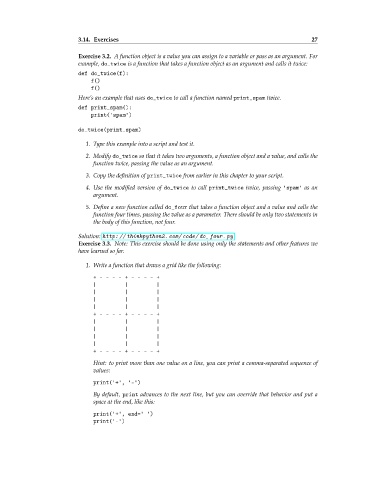Page 49 - thinkpython
P. 49
3.14. Exercises 27
Exercise 3.2. A function object is a value you can assign to a variable or pass as an argument. For
example, do_twice is a function that takes a function object as an argument and calls it twice:
def do_twice(f):
f()
f()
Here’s an example that uses do_twice to call a function named print_spam twice.
def print_spam():
print( 'spam ')
do_twice(print_spam)
1. Type this example into a script and test it.
2. Modify do_twice so that it takes two arguments, a function object and a value, and calls the
function twice, passing the value as an argument.
3. Copy the definition of print_twice from earlier in this chapter to your script.
4. Use the modified version of do_twice to call print_twice twice, passing 'spam ' as an
argument.
5. Define a new function called do_four that takes a function object and a value and calls the
function four times, passing the value as a parameter. There should be only two statements in
the body of this function, not four.
Solution: http: // thinkpython2. com/ code/ do_ four. py .
Exercise 3.3. Note: This exercise should be done using only the statements and other features we
have learned so far.
1. Write a function that draws a grid like the following:
+ - - - - + - - - - +
| | |
| | |
| | |
| | |
+ - - - - + - - - - +
| | |
| | |
| | |
| | |
+ - - - - + - - - - +
Hint: to print more than one value on a line, you can print a comma-separated sequence of
values:
print( '+', '-')
By default, print advances to the next line, but you can override that behavior and put a
space at the end, like this:
print( '+', end= ' ')
print( '-')

